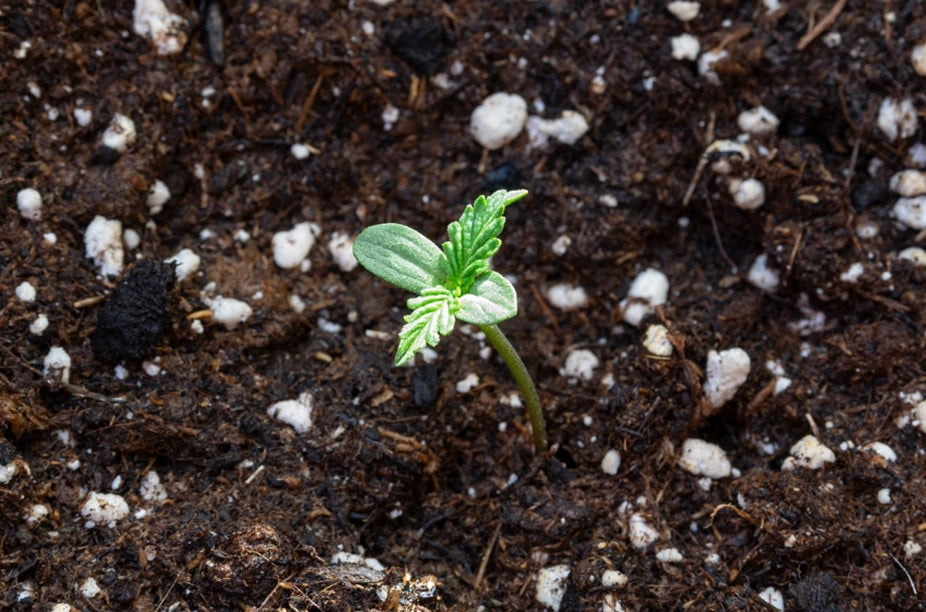
Demystifying the Cannabis Seedling Stage
Share
The cannabis plant goes through several distinct stages of growth, and each one requires different care and attention. One of the most important stages is the seedling stage, which is the period when the plant is just starting to sprout from its seed.
What is a Cannabis Seedling?
The seedling stage is the first stage of growth for the cannabis plant. It begins after the seed has germinated, and the first set of true leaves have emerged from the seed shell.
Seedlings are very small and delicate, and they are particularly susceptible to a range of environmental factors, such as temperature, humidity, and light. That is why it’s so important to give your seedlings the right conditions to thrive.
Once you have germinated seeds, the seedling begins to develop its root system, which will anchor the plant and provide it with essential nutrients and proper water.
The marijuana seedling stage typically lasts for 2-3 weeks, during these first few weeks of life your plant will need a little more care and attention. You can ensure successful growth by growing in certain containers in specific growing mediums.
Select the Right Container and Medium
Choosing the right container and medium for your weed seedlings is crucial to their growth and development. It’s important to select a container that provides adequate drainage or one that will allow you to make drainage holes. Many growers prefer to use solo cups or other small plastic containers during the seedling stage. If you decide to use a solo cup to start your seeds, cut four small holes on the bottom of the cup to allow drainage, and always save your cups to reuse repeatedly.
Besides small plastic containers, you can grow your seedlings in biodegradable pots that do not require transplanting. Keep your biodegradable pots pliable by keeping water in the nursery tray they are sitting in.
Cannabis seedling roots do not want a lot of resistance, especially at this young stage so ensuring they can easily penetrate the biodegradable pots is important. This is especially true for autoflower seedlings.
Autoflowers developed a defense mechanism that can trigger them into flowering stage when they encounter stress. Planting them into their forever home as soon as possible and limiting root-bound or stress is ideal.

Feminized cannabis seeds like Jelly Donutz can also be planted into their forever containers earlier than their non-feminized counterparts. This is because they have a 99% chance of being female compared to regular seeds that have a 50% chance of being male.
When it comes to the growing medium, there are many options to choose from, but the most important aspect of your medium is its ability to retain water. The best seedling potting mixes are high in vermiculite.
Vermiculite is a naturally occurring mineral that is often used in seedling mixes and horticulture applications. It is a soft, lightweight, and highly absorbent material that is formed by heating certain types of rocks.
Vermiculite can hold up to 3-4 times its weight in water. The water-holding capacity of vermiculite is higher than that of perlite, pumice, and rice hulls making it an excellent choice for seed starting and plants that require consistent moisture.
Besides Vermiculite your seedling mix should contain peat moss or coco coir or a combination of both. You can buy potting mixes specific for seedlings or make your own with equal portions of vermiculite and peat or coco. We recommend adding some microbially robust compost in the mix to begin building up your plants’ immune system and defense against pathogens.
Seedling mixes are unique from general potting mixes because of their increased water-holding capacity and lack of nutrition.
Use of Nutrients
During the seedling stage, cannabis seedlings don’t require much in the way of nutrients. The seed embryo contains nutrients that are used to support the initial growth and development of the seedling.
The compost within your seedling mix will contribute a small amount of nutrients to the media that your seedling can access.
You can begin adding nutrients to your water once your seedling has two sets of true leaves and at least 2-3 weeks of growth. Remember to always dilute your fertilizer to at least half-strength and use natural and organic nutrients, like kelp extract.
Kelp is a type of seaweed that is high in natural plant hormones and micronutrients, which can help to stimulate plant growth and improve overall plant health.
Kelp contains several plant hormones, including auxins, cytokinins, and gibberellins. These hormones play important roles in plant growth and development.
The natural plant hormones and micronutrients in kelp can help to stimulate root growth, improve nutrient uptake, and enhance the overall health and vitality of the plant. You can dilute kelp extract and fulvic acid into water and use it as a foliar spray over your seedlings or as a root drench when watering.


Watering
Watering cannabis seedlings properly is important, as they can be susceptible to overwatering and damping off yet need to maintain consistent moisture. Damping off is a fungal infection that affects seedlings, causing them to wilt and die. The disease is caused by several different types of fungi, including Rhizoctonia, Fusarium, and Pythium.
Damping off typically occurs in warm, humid conditions and can be exacerbated by overwatering, poor soil quality, or overcrowding of seedlings.
Symptoms of damping off include seedlings that are stunted, wilted, or have a collapsed appearance at the soil level. Infected seedlings may also have discolored stems or roots and may be easily pulled from the soil.
Temperature and Humidity
Cannabis seedlings can be sensitive to high temperatures and low humidity, and extreme conditions can potentially kill them. The ideal temperature range for cannabis seedlings is between 72-78°F, with a relative humidity of around 60-70%.
Temperatures above 90°F can be stressful to cannabis seedlings and can cause them dry out quickly. Similarly, temperatures below 50°F can also cause damage to seedlings and slow down their growth.
Low humidity levels can also be harmful to cannabis seedlings, particularly during the early stages of growth. Humidity levels below 40% can cause seedlings to dry out quickly, while humidity levels above 70-80% can create conditions favorable for fungal diseases like damping off.
Lighting
Cannabis Seeds are best started in a protected greenhouse during spring months when nighttime temperatures are above 50*F, with no added artificial lighting. Young Marijuana plants will resist flowering if they sense ever-increasing day lengths when planted under the sun.
If germinating indoors is your only option, full spectrum or blue light-leaning LEDs produce the best results. Plants will require 16-18 hours of light per day and should be placed close to the light source but not so close as to burn, this will help limit the initial elongation of the seedling and produce a much stronger, bushy plant.

It is important to keep your marijuana seedling light schedule as close to the natural light cycle as possible if they are going to end up outside. Otherwise, you can confuse your plants and trigger early flowering.
You can prepare your seedlings for life outside by slowly changing your light schedule to reflect the natural cycle by increments of 15 minutes every other day.

When to Transplant Marijuana Seedlings
It’s generally best to avoid transplanting cannabis seedlings during the seedling stage, as this can cause transplant shock and slow down their growth. Wait until the plant has developed a strong root system and is in the vegetative growth stage before transplanting it into a larger container.
This can take between 4-6 weeks of your plant growing before your seedling is ready to be transplanted. Depending on if you are using feminized seeds or regular seeds you may need to wait to transplant your young plants into their forever containers or just a larger container like a 1,2, or 3-gallon container.
If you are growing regular seeds, it may be a good idea to transplant your cannabis plant into a smaller container, so you do not waste nutrients on feeding a male plant. It can take up to 8 weeks for cannabis plants to show their sex.
If you are using a solo cup or other small plastic containers, you can determine when it is time to transplant by looking at your marijuana plants’ root development by gently pulling the soil mass from the container. You should see visible root growth along the sides of the media where it touches the container.
If you are growing cannabis in a biodegradable pot, you will plant your pot directly into a larger pot as soon as you see roots penetrating the side of your container.
It is a good idea to add beneficial mycorrhizae inoculants during every transplant to ensure a successful relationship has formed between the fungi and your plant. This will increase nutrient and water uptake and create more robust plants.
The cannabis seedling stage is a delicate period in the plant’s growth and requires careful attention to ensure its survival. By selecting the right container and medium, providing adequate nutrients and water, maintaining the proper temperature and humidity, and providing adequate lighting, you can help your cannabis seedlings grow into healthy, strong plants.

